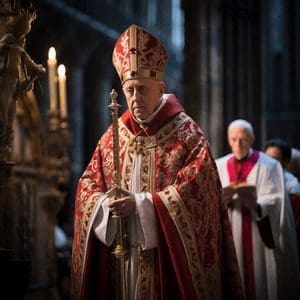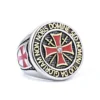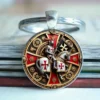This article will offer a detailed exploration of the role of religion in the Anarchy, with a specific focus on the Church’s power in Medieval England’s Anarchy, enriching our understanding of this tumultuous period in history.
The Anarchy: A Period of English History Defined by Power Struggles
The Anarchy, a term used to describe the turbulent period in England from 1135 to 1153, remains one of the most compelling chapters in medieval history. It was a time marked by a bitter civil war, ensuing after the death of King Henry I, leading to a power vacuum that pitted Stephen of Blois against Empress Matilda in a struggle for the English throne. This era, characterised by its lawlessness and breakdown of royal authority, presents a unique lens through which to explore the role of religion in shaping political power.
Role of Religion in the Anarchy: A Key Analytical Perspective

The role of religion during the Anarchy, particularly the influence wielded by the Church, forms a central theme in understanding the period’s historical significance. Religion was not just a spiritual guide but a formidable force in medieval politics.
The Church’s Power in Medieval England’s Anarchy
In medieval England, the Church was a pivotal institution, its power often rivalling that of the monarchy. During the Anarchy, this power manifested itself in various ways. The Church was a major landowner, controller of wealth, and a key influencer of public opinion. Its leaders, such as bishops and abbots, held significant sway over both the nobility and commoners. Understanding the Church’s involvement provides insights into the broader socio-political dynamics of the time.
Exploring the Interplay Between Secular and Spiritual Authority
This article will explore the intricate dance between secular and spiritual authority during the Anarchy. It will examine how the Church’s moral and political stances influenced the legitimacy of claimants to the throne, the conduct of war, and the eventual peace process. In doing so, it will highlight how the Church’s power in Medieval England’s Anarchy was not just a backdrop but a driving force in the period’s events.
Historical Background
The Church’s Influence in Medieval England
Before delving into the role of religion in the Anarchy, it’s essential to understand the Church’s standing in medieval England. As a powerful entity, the Church held immense sway over both spiritual and secular matters. This influence was not just limited to guiding the moral compass of society but extended into the realms of politics and governance. The Church’s power in Medieval England’s Anarchy was rooted in its vast land holdings, wealth, and the loyalty of its followers, making it a central figure in the power dynamics of the time.
The Succession Crisis Post-King Henry I
The death of King Henry I in 1135 plunged England into a state of uncertainty, marking the beginning of the Anarchy. Henry’s failure to secure a clear line of succession led to a fierce power struggle between his daughter, Empress Matilda, and his nephew, Stephen of Blois.

This succession crisis created a vacuum that tested the loyalties and power of England’s leading institutions, including the Church. The role of religion in the Anarchy becomes apparent here, as both claimants sought the Church’s support to bolster their legitimacy.
Power Dynamics: The Church and the Monarchy
The relationship between the Church and the monarchy before the Anarchy set the stage for the events that followed. The Church, enjoying relative autonomy and significant influence, often found itself at odds with royal ambitions. This period saw a constant tug of war for power and control, with the Church striving to maintain its authority over spiritual matters and the Crown seeking to consolidate power. Understanding these pre-Anarchy dynamics is crucial to comprehending the Church’s power in Medieval England’s Anarchy and its subsequent role in the civil war.
Religion as a Political Tool
Religion in medieval times was not just a matter of personal belief but a powerful political tool. The Church’s endorsement was vital for any ruler to maintain legitimacy and authority. This aspect was particularly pronounced during the Anarchy, where the role of religion transcended spiritual guidance and became a decisive factor in the struggle for the English crown. Both Matilda and Stephen were acutely aware of the Church’s power in Medieval England’s Anarchy and sought to use it to their advantage.
Key Figures and Events
Profiles of Significant Religious and Royal Figures
During the Anarchy, several key figures emerged, each playing a pivotal role in shaping the course of events. Their actions and decisions were heavily influenced by the intertwining of religious and political powers.
A. Stephen of Blois

Stephen of Blois, crowned King of England, was a central figure during the Anarchy. His reign was marked by his efforts to consolidate power amidst widespread unrest. Stephen’s relationship with the Church was complex; initially receiving strong support from religious leaders, his authority was later challenged due to various political and military setbacks. His role in the Anarchy highlights the delicate balance between royal and religious powers.
B. Empress Matilda
Empress Matilda, the daughter of King Henry I and a claimant to the throne, represented the other major faction in the Anarchy. Her pursuit of the crown was significantly influenced by her alliances with key religious figures.

Matilda’s struggle for power demonstrates the critical role of religion in the Anarchy, particularly how the Church’s power in Medieval England’s Anarchy could sway the tides of political fortune.
C. Archbishop Theobald of Canterbury

Archbishop Theobald of Canterbury was a leading religious figure during this period.
His role as a mediator and advisor to both Stephen and Matilda underscores the significant influence of the Church in the Anarchy. Theobald’s actions reflect the Church’s power in Medieval England’s Anarchy, balancing religious duties with political pragmatism.
The Church’s Role in the Anarchy
Political Involvement of the Church
During the Anarchy, the Church’s role was not limited to spiritual guidance; it played a significant part in the political sphere. The era highlighted the Church’s power in Medieval England’s Anarchy, as it became a key player in the struggle for the throne. Church leaders, leveraging their influence, often swayed public opinion and political decisions. The support of the Church was a coveted asset for both Stephen and Matilda, as it could tip the balance in this tumultuous period.
A. Influence Over Nobility and Commoners
The Church’s influence extended across all levels of society. Its authority over the nobility was evident in its ability to mediate disputes and provide moral guidance. For the common people, the Church was a constant presence, shaping their worldviews and allegiances. This broad influence underscored the role of religion in the Anarchy, as the Church’s stance could impact the loyalties of both the ruling class and the general populace.
B. Alignment with Different Claimants
The Church’s alignment in the Anarchy was complex. Initially, many church leaders supported Stephen, but as the conflict dragged on, some began to shift their support to Matilda. This change in allegiance was not merely a religious decision but a strategic move, reflecting the Church’s understanding of the political landscape. The role of religion in the Anarchy is evident in these shifts, as the Church’s support was a crucial factor in the legitimacy of the claimants.
The Church as Mediator and Peacekeeper
In addition to its political role, the Church also acted as a mediator and attempted to bring peace to a divided nation.
A. Attempts at Brokering Peace
The Church’s leaders, notably the Archbishop of Canterbury, made several attempts to negotiate peace between Stephen and Matilda. These efforts highlighted the Church’s power in Medieval England’s Anarchy, as it was one of the few institutions capable of bringing the warring parties to the negotiating table.
B. Moral Authority in Conflict Resolution
The Church’s moral authority was a vital tool in its peacekeeping efforts. It used its position to advocate for a resolution to the conflict, often reminding both sides of the moral implications of their actions. This aspect of the Church’s role in the Anarchy was crucial, as it provided a moral compass during a time of widespread lawlessness and chaos.
Impact on the Church’s Internal Affairs
The Anarchy also had significant repercussions within the Church itself.
A. Strains Within the Church
The Church’s involvement in the Anarchy created internal strains. The differing allegiances of its leaders sometimes led to conflicts within the institution, reflecting the broader divisions in the country. These internal struggles were a testament to the role of religion in the Anarchy, as the Church grappled with its position in the political landscape.
B. Changing Public Perception
The Church’s active role in the Anarchy also affected how it was perceived by the public. Some viewed the Church’s involvement in politics as overreach, while others saw it as a necessary step to restore order. This shift in perception is an important aspect of the Church’s power in Medieval England’s Anarchy, as it influenced its long-term relationship with both the monarchy and the populace.
In conclusion, this section highlights the multifaceted role of the Church during the Anarchy. From influencing political decisions to attempting to broker peace, the Church’s involvement was pivotal in shaping the course of this tumultuous period. Its actions not only affected the immediate outcome of the conflict but also had lasting impacts on its own internal dynamics and its relationship with the English monarchy and society.
The Crown’s Interaction with Religion during the Anarchy
The Use of Religious Symbolism and Rhetoric
During the Anarchy, the monarchy’s engagement with religion was multifaceted, often using religious symbolism and rhetoric to strengthen its position.
A. Legitimacy Claims Based on Divine Right
The concept of divine right played a crucial role in the monarchy’s claim to legitimacy. Both Stephen and Matilda leveraged this idea, portraying their right to rule as ordained by God. This usage of religious justification was a key aspect of the role of religion in the Anarchy. It highlights how the Crown sought to align itself with divine will to solidify its authority in the eyes of the people and the Church.
B. Mobilisation of Religious Sentiments
The Crown also used religious sentiments to mobilise support. By aligning their cause with religious principles, both claimants to the throne aimed to garner the backing of the Church and its followers. This strategy underscores the Church’s power in Medieval England’s Anarchy, as the monarchy recognised the Church’s influence over public opinion.
The Crown’s Manipulation of Religious Institutions
The Crown’s interaction with the Church during the Anarchy was not solely based on reverence and deference; it also involved strategic manipulation of religious institutions.
A. Appointments and Dismissals of Bishops and Abbots
One of the key ways in which the Crown exercised its influence over the Church was through the appointment and dismissal of bishops and abbots. These positions were not just religious but also held significant political power. By controlling these appointments, the Crown attempted to ensure the Church’s support and, by extension, its influence over the people.
B. Confiscation of Church Properties and Revenues
Another aspect of the Crown’s strategy was the confiscation of Church properties and revenues. This not only provided financial resources to the monarchy but also served as a means to exert pressure on the Church. The role of religion in the Anarchy is evident here, as the Crown’s actions were both a cause and consequence of the Church’s power in Medieval England’s Anarchy.
The Impact of Religious Conflicts on Royal Authority
The Crown’s relationship with the Church during the Anarchy was not without conflict, and these tensions had significant implications for royal authority.
A. Excommunications and Interdicts
One of the most direct confrontations between the Church and the Crown was the threat and execution of excommunications and interdicts. These actions by the Church were powerful tools that could undermine the monarchy’s legitimacy and authority. They highlight the Church’s power in Medieval England’s Anarchy, as the Crown had to navigate these religious sanctions carefully.
B. Negotiations and Concessions to the Church
In response to the Church’s power and influence, the Crown often found itself negotiating with religious leaders and making concessions. These negotiations were a testament to the role of religion in the Anarchy, as the monarchy recognised the need to maintain a favourable relationship with the Church to secure its position.
Important Events Highlighting the Church-Crown Dynamics
Several key events during the Anarchy exemplify the intricate relationship between the Church and the Crown.
A. The Treaty of Wallingford
The Treaty of Wallingford, brokered in 1153, was a turning point in the Anarchy. This agreement, which paved the way for a peaceful succession after Stephen’s death, was heavily influenced by the Church’s intervention. The role of religion in the Anarchy is evident here, as the Church’s mediation was crucial in resolving the prolonged conflict.
B. The Role of the Church in the Coronation of Stephen
The coronation of Stephen was a significant event, as it involved the Church’s direct participation in legitimising a monarch. The ceremony, conducted by religious leaders, highlighted the Church’s power in Medieval England’s Anarchy. It demonstrated how the Church’s support was essential for establishing a ruler’s legitimacy.
C. Disputes over Ecclesiastical Appointments
The Anarchy period saw numerous disputes over ecclesiastical appointments. These conflicts between Stephen, Matilda, and various religious figures underscore the role of religion in the Anarchy. They reveal the strategic importance of controlling religious offices and the influence these positions held in medieval politics.
Consequences and Legacy
Long-Term Impacts on the Church
The Anarchy, a period defined by its civil strife and power struggles, left a lasting impact on the Church, altering its role and relationship with the state.
A. Changes in Church-State Relations
One of the most significant legacies of the Anarchy was the transformation in the relationship between the Church and the state. The conflict highlighted the Church’s power in Medieval England’s Anarchy, leading to a reevaluation of its political involvement. Post-Anarchy, there was a gradual shift towards clearer boundaries between religious and secular authorities, reshaping the Church’s role in English politics.
B. Influence on Future Ecclesiastical Policies
The events of the Anarchy also influenced the Church’s internal policies and its approach to governance. The Church emerged with a renewed sense of its spiritual mission, striving to balance its religious duties with its temporal influence. This period marked a turning point in the Church’s history, setting precedents for its future engagements in political matters.
Long-Term Impacts on the Monarchy
The monarchy, too, underwent significant changes in the aftermath of the Anarchy, with lasting implications for English governance.
A. Development of Royal Power Post-Anarchy
The resolution of the Anarchy led to the strengthening of royal power. The monarchy, having navigated the turbulent waters of civil war and religious politics, emerged with a clearer understanding of the need to maintain a stable relationship with the Church. This period also saw the beginning of efforts to consolidate royal authority and reduce the influence of unruly barons, setting the stage for future monarchs.
B. Lessons Learned Regarding Religious Alliances
The Anarchy taught important lessons about the role of religion in royal politics. Monarchs became more aware of the need to balance their secular authority with religious diplomacy. The understanding of the Church’s power in Medieval England’s Anarchy influenced how future kings engaged with religious institutions, often seeking to align their interests without directly challenging the Church’s autonomy.
The Anarchy’s Influence on English History and Society
The Anarchy was not just a power struggle; it was a period that shaped the course of English history and society.
A. Legal and Administrative Reforms
The need for stability and order post-Anarchy led to significant legal and administrative reforms. These reforms were partly influenced by the lessons learned during the conflict, particularly the need for a strong, centralised government and a more systematic legal system.
B. The Evolution of English Identity
The Anarchy also played a role in shaping English national identity. The conflict, often seen as a struggle between different dynastic factions, contributed to a growing sense of Englishness. The role of religion in the Anarchy, particularly the Church’s mediation and moral guidance, influenced the societal values and norms that emerged in its aftermath.
Reflecting on the Role of Religion in the Anarchy
The Anarchy, a defining period in medieval England, was profoundly influenced by the interplay between religion and politics. This article has explored the role of religion in the Anarchy, particularly focusing on how the Church’s power in Medieval England’s Anarchy shaped the course of this turbulent period. The influence of the Church extended beyond the spiritual realm, deeply impacting the political landscape and the outcome of the succession crisis.
The Church’s Power and its Implications
The Church’s involvement in the Anarchy was multifaceted. It acted as a political player, a mediator, and a moral authority. The Church’s power in Medieval England’s Anarchy was not only evident in its ability to influence the nobility and the populace but also in its role in shaping the policies and actions of the monarchy. This period highlighted the Church’s significant sway over both secular and spiritual matters, underlining the intricate relationship between religious and political powers in medieval society.
The Crown’s Navigations and Strategies
On the other side, the Crown’s approach to dealing with the Church during the Anarchy was a complex dance of alliance, manipulation, and sometimes confrontation. The monarchy’s use of religious symbolism, control over ecclesiastical appointments, and responses to religious conflicts reflected a keen awareness of the Church’s power. This interaction between the Crown and the Church was a key aspect of the Anarchy, demonstrating how political authority was often intertwined with religious influence.
Legacy of the Anarchy
The consequences and legacy of the Anarchy are far-reaching. This period of conflict brought about significant changes in church-state relations, influencing future ecclesiastical policies and the development of royal power. The legal and administrative reforms initiated in its wake laid the foundation for the evolution of the English state and society. Moreover, the Anarchy played a crucial role in shaping English national identity, with the Church’s involvement being a significant factor in this proces.





